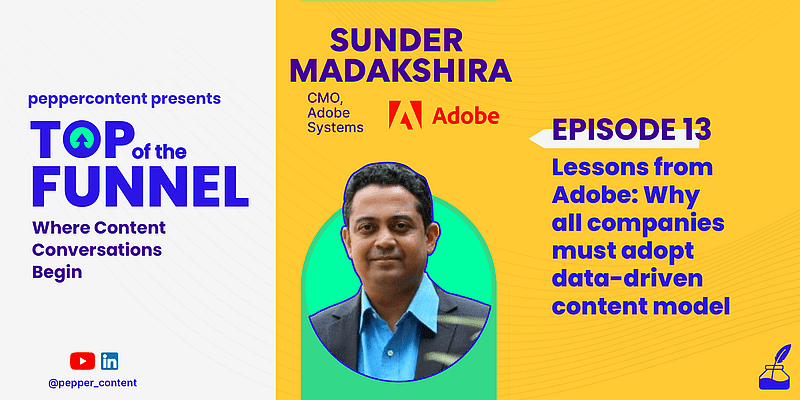Adobe is the global leader in digital media and digital marketing solutions. Their creative, marketing, and document solutions are powerful tools used by everyone – from emerging artists to global brands.
In this week’s episode of Pepper Content’s Top of the Funnel series, Natasha Puri, Content Marketing Lead at Pepper, chats with Sunder Madakshira, Chief Marketing Officer at Adobe Systems, about how content has taken the central place in Adobe’s overall marketing strategy, the role of the content function in B2B and B2C services, and a lot more.
Marketer’s value add for consumers today
Sunder has 25 years of extensive experience in leadership roles in sales and marketing across B2C, B2B products and services. He has worked with SAP, Infosys, Wipro, and VISA before his current role at Adobe. He has been recognised among India’s best CMOs at various thought leadership forums. Shedding light on how he has seen content and digital marketing evolve over time, he says that in 2011, digital platforms became something more than engagement platforms, and now they have become the cornerstones of marketing.
Today, a marketer’s biggest value add to their consumers is:
- Giving them a perspective and helping them make up their mind about purchasing your product or service
- Delivering value from the product or service
- Ensuring that they are convinced about their purchase and it remains in their mind
Watch the video here:
The B2C and B2B context
When asked about the difference between B2B and B2C as far as content and digital marketing are concerned, Sunder explains that B2B is centred around a finite segment of customers while B2C typically uses mass media and is seamless. “The main difference is between call to actions (CTA), channels, and messaging.”
In B2B, the CTA has to be very pronounced, focused, and short. It has to be clear in what it wants to convey. Sales cycle steps can be dismally short, and thus the interventions are very calibrated, focused and a certain outcome can be expected at the end of every intervention. Thus, here, the focus is on marketing ROI since the investments can be high, and so the returns have to be proportionate. So, in B2B, a data analytics platform can be very helpful to track success.
However, in B2C, a lot more effort must be put into achieving the same things since it is an omnichannel situation. Mass media is the way to go here, and because of it, you have marketing information coming in from various sources. Thus, you need a very robust platform to integrate that info and plan the future strategy.
Role of content marketing at Adobe
At Adobe, as Sunder informs, there is a lot of focus on data, analysis, and delivery of the right content to the right audience.
“Content has changed in texture like using more video, audio, and text content. But the main aim is also that the right audience sees the suitable content with the right message. For example, a new user will not want to see advanced content. So tailoring is important,” he says.
Thus, Adobe leverages something called as Data-Driven Operative Model (DDOM). They also indulge in account-based marketing for strategic and transformational accounts.
Sunder sees Adobe delivering explicitly curated content to specific audiences in the next four years.
Pillars of Adobe’s content strategy
- Thought leadership: Keep the readers engaged, give them a fair idea of the industry vertical of Adobe products, help them envision the digital world, and give an idea of the future of digital marketing.
- Education and enablement: Answer all how-to user questions like how to get started, how to implement a solution, what are the themes one should choose, how to show value to their company and how to make a realistic and visionary business case.
- Engagement: This includes a continuous stream of content involving the new developments in the industry, what we can learn from competitors, and helping consumers be up-to-date about the industry.
How to map ROI in content marketing?
Sunder explains that ROI mapping gets complex when it is not done the right way. No system or metric is perfect. Every measurement system has an option to better itself and to make it better, you need:
- 100 percent transparency
- No sharp pointers, but a strong sense of judgment
- Combination of data and qualitative aspects
- Typical business metrics like increased revenue, profitability, category penetration, market share, etc.
Content fit in overall marketing strategy
Sunder gives three tips on how small businesses can start content marketing:
- Start with a definite aim, like a picture of success in a certain time frame.
- Start with what you have. Don’t wait for any tool or integration of data, etc. Be aware of what data input you have made to a certain marketing channel and set your expectations accordingly.
- Think of one area and show impact. An organisation needs confidence, so give that to your team. Be proud of small successes. Take accountability for your deliverables.
Lastly, talking about if content creation depends on the channel or is it vice versa, Sunder concludes,
“It is always content for me. If you have great content, things will work out no matter what. In the B2B scene, content makes a lot of impact. If the content isn’t right, the channel can’t do anything to hide the mediocrity.”







![Read more about the article [Turning Point] How the pandemic enabled B2B ecommerce unicorn ElasticRun to find product-market fit](https://blog.digitalsevaa.com/wp-content/uploads/2022/02/MalvikaCopyofImageTagging39-1645793746067-300x150.png)

